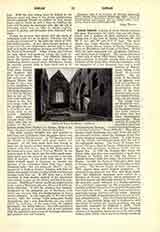

Ionian Islands, a group of seven islands (whence the name Heptanesus, by which they are also designated) and a number of islets scattered over the Ionian Sea to the west of Greece, between 36° and 40° N. lat., and 19° and 23.5° E. long. The seven islands are: Corfu (kerkura, Corcyra), Paxos, Leucadia or Santa Maura, Ithaca or Thiaki, Cephalonia, Zante or Zacynthus, and Cerigo or Cythera. Of the islets the most important are: Antipaxos, Othronos, and Anticythera or Cerigotto. The Ionian Isles have a total area of about 1095 square miles. The population amounts to 261,930, among them being 6615 Catholics of the Latin Rite, while the remainder, with the exception of a few thousand Jews and a small number of Mussulmans, belong to the Greek Orthodox Church. The climate of the islands is in general very mild and salubrious, and, in spite of the mountainous character of the land, there is a fairly extensive output of cotton, wine, oil, and raisins. The Ionian Isles are frequently mentioned or described by the ancient Greek and Latin authors, for whom they had many mythological associations. Many remains of antiquity are even today found on these islands (Rieman, “Recherches archeologiquessur les Iles ioniennes”, Paris, 1879-80). They all remained under Byzantine rule until about the end of the eleventh century, when the Normans of the Two Sicilies obtained possession of Corfu. In 1386 Venice took the islands, and retained them until the end of the eighteenth century. The Treaty of Campo Formio in 1797 gave them to France, which formed them into the three provinces of Ithaca, Corfu, and the Aegean Sea. In 1799 the Russian fleet seized the Ionian Isles, and they were constituted a small state tributary to Turkey, but in 1802 the Treaty of Amiens declared them free under the protectorate of Russia. In 1807 the Peace of Tilsit gave them back to France, and General Berthier was installed as their governor. The Second Treaty of Paris (November, 1815) placed them under English protection. An aristocratic government was then once more organized; the legislative functions were vested in a chamber of seventy deputies, eleven nominated by the Government and fifty-nine elected by the people; the executive power belonged to a Senate consisting of a president, appointed by the protecting power, and five senators elected for five years by the deputies from their own body. An English lord commissioner controlled foreign relations and the police. England enjoyed the right of garrisoning the forts and of military administration. After the French Revolution of 1848, an insurrection broke out in Cephalonia with the object of uniting the islands to Greece, but was rigorously repressed by England in 1849. From that time, however, the first vote of the Chamber, whenever it assembled, was in favor of the union with Greece, after which vote it was immediately dissolved. The English Government, after sending Mr. Gladstone to investigate the feeling of the population, at last decided to surrender the islands to Greece. King George I, upon ascending the throne at Athens, in 1863, consented to succeed Otho I only upon England‘s undertaking to cede the Ionian Archipelago to the Hellenic Kingdom. This cession was effected between May 21 and June 2, 1864. The Ionian Isles have since then formed the three nomarchies, or departments, of Corfu, Cephalonia, and Zante. Cerigo alone has been incorporated in the continental nomarchy of Messenia.
The Ionian Isles must have received the Gospel at a comparatively early date. The first known Bishop of Corfu is Apollodorus, or Alethodorus, who assisted at the Council of Nicaea in 325 (Gelzer, “Patrum nicaenorum nomina”, LXIII, no. 168; see also the list of ancient Greek bishops in Lequien, II, 232-5). After the consummation of the Eastern Schism, the Ionian bishoprics remained in the power of the schismatics. Until 1260 the archipelago of the seven islands counted scarcely any Catholics. Under the domination of the House of Anjou, Catholicism made some progress there, and this was continued from 1386 to 1797 under Venetian rule. In the thirteenth century Zante and Cephalonia were made Latin bishoprics, suffragan to Corinth until 1386. These two dioceses (Zante and Cephalonia) were then made one and suffragan to Corfu, which was then raised to the status of an archbishopric (see the list of Latin bishops of the three sees in Lequien, III, 877-82, 889-92; completed by Gams, 399, 430, and Eubel, I, 217). The political vicissitudes through which the Ionian Archipelago passed during the nineteenth century brought adversity to the Catholic missions, which, however, suffered less after 1850. At the time of the cession of the islands to Greece in 1864, the Hellenic Government promised to secure to the three Latin bishoprics their former rights and privileges. The Archdiocese of Corfu (which, besides the island of that name, comprises the islands and islets of Merlera, Phano, Samothrace, Paxos, and Antipaxos, as well as a few places in Epirus on the mainland between the towns of Parga and Sasina) is now governed by a resident archbishop, who is at the same time Administrator Apostolic of the Diocese of Zante-Cephalonia. This last diocese comprises, besides the two islands from which it derives its name, those of Santa Maura Leucas (or Leucadia), Ithaca, and Cerigo. The archdiocese numbers about 6000 Catholics, all of the Latin Rite; the Diocese of Zante-Cephalonia, 615 (Missiones catholicw,1907, 145-7). (See Archdiocese of Corfu; Diocese of Zante-Cephalonia.) The Orthodox hierarchy until 1900 consisted of seven dioceses, one for each of the principal islands of the Ionian Archipelago; since then it has numbered but five, that of Paxos having been suppressed, and the two titles of Leucas and Ithaca united into one. Formerly dependent on the Phanar of Constantinople, the ecclesiastical eparchies of the ancient septinsular republic became connected in 1866 with the Holy Synod of Athens, to which they are still subject [Thearvic, “L’Eglise de Grece” in “Echos d’Orient”, III (1899-1900), 288 sqq.]. (See Greece.)
S. SALAVILLE

